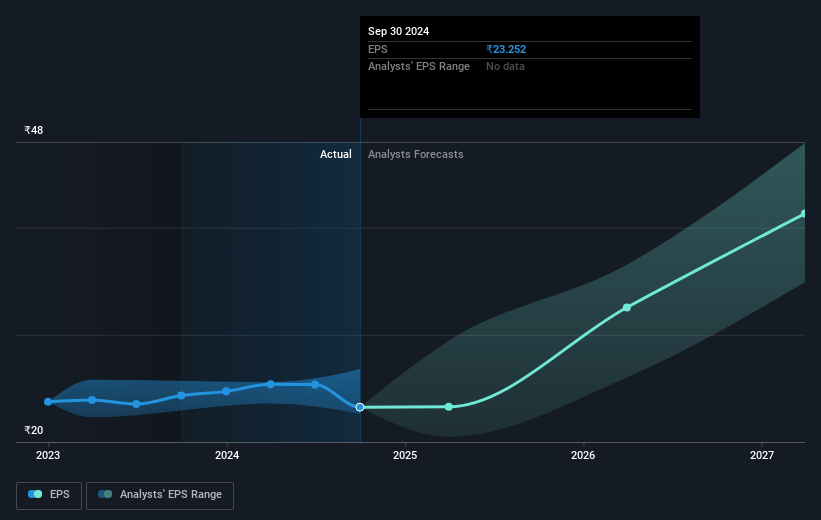Key Takeaways
- Digital partnerships and growing online transactions could boost revenues, while AI-driven efficiencies may improve margins and lower costs.
- Hyper-personalization and asset quality focus could enhance customer engagement and satisfaction, supporting earnings and long-term growth.
- Increasing UPI and RuPay usage, elevated defaults, consumer spending shifts, and regulatory changes pose risks to SBI Cards' market share and profitability.
Catalysts
About SBI Cards and Payment Services- A non-banking financial company, issues credit cards to individual and corporate customers in India.
- The increasing preference for credit card use in online purchases and the projected growth in digital transactions may boost SBI Cards' revenue, given the growing digital economy and the company's strategic e-commerce partnerships with major platforms like Amazon and Flipkart.
- The launch of a hyper-personalization platform is expected to enhance customer lifetime value and engagement, potentially increasing future earnings through targeted marketing, higher customer satisfaction, and retention.
- The integration of digital acquisition capabilities and AI-driven efficiencies in application processing could lower operational costs and error rates, potentially improving net margins.
- Continuous improvements in asset quality, with strengthened underwriting standards and a focus on higher credit-score customers, could lead to moderated credit costs, ultimately supporting net margin expansion.
- A strong liquidity position and healthy capital adequacy ratio provide the financial flexibility to support future growth, positively impacting future revenue and earnings through sustainable expansion and risk management.
SBI Cards and Payment Services Future Earnings and Revenue Growth
Assumptions
How have these above catalysts been quantified?- Analysts are assuming SBI Cards and Payment Services's revenue will grow by 30.1% annually over the next 3 years.
- Analysts assume that profit margins will shrink from 20.3% today to 16.9% in 3 years time.
- Analysts expect earnings to reach ₹37.6 billion (and earnings per share of ₹39.51) by about March 2028, up from ₹20.4 billion today. However, there is a considerable amount of disagreement amongst the analysts with the most bullish expecting ₹45.4 billion in earnings, and the most bearish expecting ₹32.8 billion.
- In order for the above numbers to justify the analysts price target, the company would need to trade at a PE ratio of 30.9x on those 2028 earnings, down from 39.4x today. This future PE is greater than the current PE for the IN Consumer Finance industry at 17.7x.
- Analysts expect the number of shares outstanding to remain consistent over the next 3 years.
- To value all of this in today's terms, we will use a discount rate of 16.47%, as per the Simply Wall St company report.
SBI Cards and Payment Services Future Earnings Per Share Growth
Risks
What could happen that would invalidate this narrative?- The increasing preference for UPI and RuPay transactions presents a risk to SBI Cards, as it may lead to reduced market share and revenues in credit card spending if more consumers shift to these platforms.
- The tight collection environment and elevated defaults in the unsecured credit portfolio can lead to higher credit costs and negatively impact net margins.
- A decline in customer quality due to increased leverage and higher credit limits may result in elevated credit costs, impacting earnings negatively.
- With the revolver rate and interest-earning asset rates stable but at risk of decline, this can affect the profitability, as revolver rates contribute substantially to interest income and net margins.
- Competitor pressure and changes in consumer spending habits, along with regulatory changes impacting digital payment methods, could lead to volatility in revenue growth trajectories.
Valuation
How have all the factors above been brought together to estimate a fair value?- The analysts have a consensus price target of ₹772.13 for SBI Cards and Payment Services based on their expectations of its future earnings growth, profit margins and other risk factors. However, there is a degree of disagreement amongst analysts, with the most bullish reporting a price target of ₹1000.0, and the most bearish reporting a price target of just ₹581.0.
- In order for you to agree with the analyst's consensus, you'd need to believe that by 2028, revenues will be ₹222.1 billion, earnings will come to ₹37.6 billion, and it would be trading on a PE ratio of 30.9x, assuming you use a discount rate of 16.5%.
- Given the current share price of ₹846.5, the analyst price target of ₹772.13 is 9.6% lower. The relatively low difference between the current share price and the analyst consensus price target indicates that they believe on average, the company is fairly priced.
- We always encourage you to reach your own conclusions though. So sense check these analyst numbers against your own assumptions and expectations based on your understanding of the business and what you believe is probable.
How well do narratives help inform your perspective?
Disclaimer
Warren A.I. is a tool utilizing a Large Language Model (LLM) that ingests data on consensus price targets, forecasted revenue and earnings figures, as well as the transcripts of earnings calls to produce qualitative analysis. The narratives produced by Warren A.I. are general in nature and are based solely on analyst data and publicly-available material published by the respective companies. These scenarios are not indicative of the company's future performance and are exploratory in nature. Simply Wall St has no position in the company(s) mentioned. Simply Wall St may provide the securities issuer or related entities with website advertising services for a fee, on an arm's length basis. These relationships have no impact on the way we conduct our business, the content we host, or how our content is served to users. The price targets and estimates used are consensus data, and do not constitute a recommendation to buy or sell any stock, and they do not take account of your objectives, or your financial situation. Note that Warren A.I.'s analysis may not factor in the latest price-sensitive company announcements or qualitative material.




